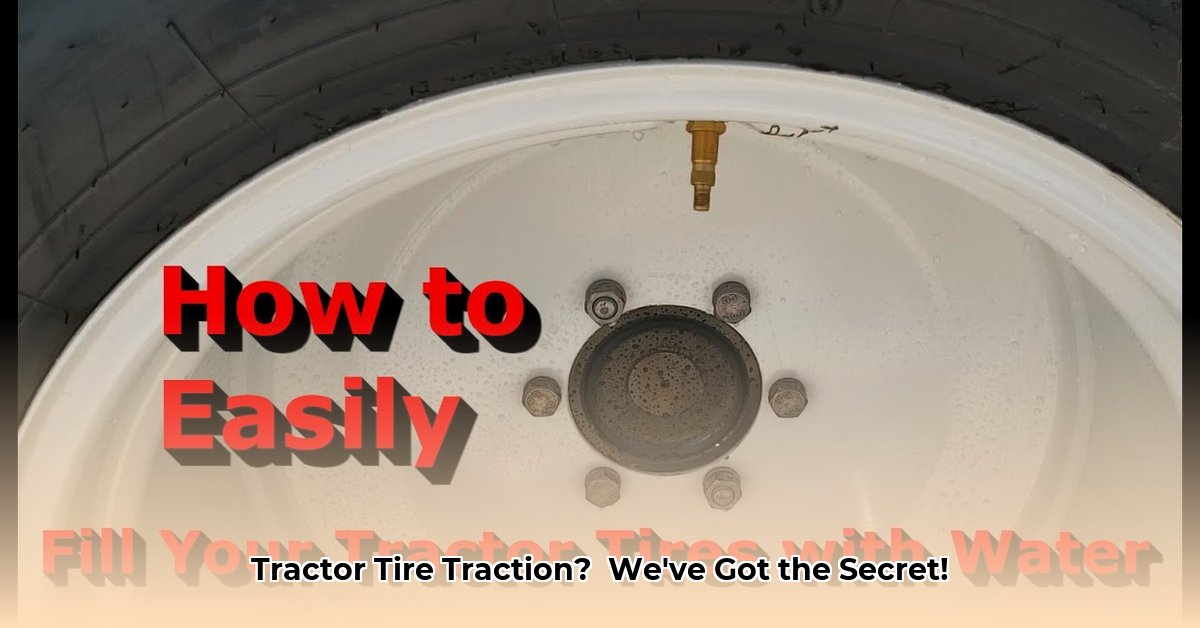
Dealing with a tractor that slips and slides, or struggles for grip? Adding water (or other fluids) to your tractor tires significantly boosts traction and stability, improving performance and reducing soil compaction. This comprehensive guide provides a step-by-step process, safety precautions, explores alternative ballast options, and offers valuable maintenance tips. For a more detailed guide, see this helpful resource.
Safety First: Gear Up and Get Ready
Before you begin, prioritize safety. This isn't just a suggestion; it's essential. Always wear sturdy work gloves to protect your hands from scrapes and potential chemical irritants (depending on the ballast you choose). Safety glasses or goggles are a must to prevent eye injuries from splashes. Finally, and critically, check your tire pressure before adding any fluid. Knowing the starting pressure helps prevent overfilling, a major safety hazard that can lead to dangerous blowouts.
Gathering Your Supplies: What You’ll Need
You'll need minimal equipment: a garden hose (a longer one is more convenient), a funnel (for clean filling and preventing spills), a measuring tape or marker (for precise water level tracking), and optionally, tire sealant (discussed later). Having a helper, particularly for larger tires, significantly speeds up the process and enhances safety. A pressure gauge is also recommended for accurate tire pressure monitoring.
Step-by-Step Guide: Filling Your Tractor Tires with Water
Here's a straightforward, numbered guide:
Locate the Valve: Find the valve stem (a small metal nipple) on the inside of the wheel. Consult your tractor's manual if needed, as locations vary.
Attach the Funnel: Securely attach the funnel to the valve stem to prevent leaks and spills. A small amount of tire sealant around the connection adds extra security.
Add Water Slowly: Gradually add water through the funnel. Avoid rapid filling to prevent pressure spikes. Most tires recommend filling to about 75% capacity; check your owner's manual for precise specifications. Overfilling is extremely dangerous.
Monitor Progress: Regularly check the water level using your measuring tape or marker. Mark progress on the tire sidewall. Remember, adding more water is easier than removing it.
Secure the Valve: Once the desired water level is reached, remove the funnel and securely replace the valve cap to prevent leaks.
Troubleshooting Common Issues: Dealing with Leaks
Leaks are a common problem. Small leaks might be repairable with a tire sealant. However, significant leaks usually require professional attention. Ignoring leaks can lead to tire damage and unsafe operating conditions. Don't hesitate to consult a tire specialist for major issues.
Alternatives to Water: Weighing Your Options
While water is cheap and readily available, it freezes in cold climates. Consider these alternatives:
| Ballast Type | Pros | Cons | Cold Climate Suitability |
|---|---|---|---|
| Water | Inexpensive, readily available, environmentally friendly | Freezes in cold climates, potential for corrosion | Poor |
| Antifreeze (PG) | Effective in cold climates, offers some corrosion protection | More expensive, potentially harmful to the environment if improperly disposed | Excellent |
| Calcium Chloride | Cost-effective, highly effective ballast | Highly corrosive, can damage tires and other components, environmental concerns | Excellent |
| Polyurethane Foam | Permanent solution, no freezing, excellent ballast | Significantly more expensive, often requires professional installation | Excellent |
The best option depends on your budget, climate, and environmental priorities. "Water remains a popular choice for its cost-effectiveness," says Dr. Emily Carter, Agricultural Engineer at Purdue University, "but its limitations in cold climates are a critical consideration."
Maintenance and Long-Term Care: Keeping Your Tires in Top Shape
Regularly check tire pressure (at least weekly) and water levels. Address any leaks immediately. Dispose of used ballast fluids responsibly, adhering to local environmental regulations. Consistent maintenance ensures optimal tractor performance and safety.
Choosing the Right Ballast: A Practical Guide
Choosing the best ballast is crucial for long-term performance and safety. "The ideal ballast depends on your specific needs and local climate," notes Professor Robert Miller, Extension Specialist in Agricultural Engineering at University of California, Davis. Consider cost, environmental impact, and climate conditions before making your decision. A well-weighted tire contributes significantly to greater tractor control and improved safety.